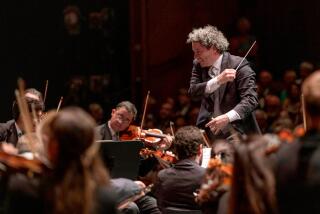Review: Conductor adds French flair to Rotterdam Philharmonic
Mezzo-soprano Joyce DiDonato once called the compact, muscular conductor Yannick Nézet-Séguin “Mighty Mouse,” and after his electrifying appearance at Valley Performing Arts Center on Tuesday with the Rotterdam Philharmonic Orchestra, one sees what she means.
Conductors need a lot of energy, but Nézet-Séguin is on another level. On a scale of one to 10, he goes to 11.
The last time the French Canadian brought the Rotterdam Philharmonic to the U.S., in 2009-10, the dates were generally concentrated on the East Coast and Canada. This time Angelenos can see why the 39-year-old Nézet-Séguin is one of the great conductors of this generation, as the orchestra’s North American tour moves to dates in Costa Mesa, Palm Desert, San Diego and San Francisco over the next week.
ESSENTIAL ARTS & CULTURE NEWSLETTER >> Get great stories delivered to your inbox
Now in his seventh season as music director of the Rotterdam, Nézet-Séguin succeeded Valery Gergiev, who had led the orchestra for 12 years. He’s also in his third season as music director of the Philadelphia Orchestra and has led his hometown ensemble Orchestre Métropolitan (Montreal) for 15 years.
On Tuesday, two grand staples of the concert repertoire were featured: Prokofiev’s Fifth Symphony and Tchaikovsky’s Fifth Symphony. Both were given stunning renditions by Nézet-Séguin and his ensemble, demonstrating how Rotterdam’s Russian tradition (fostered under Gergiev) has slowly been transformed by his more Gallic sensibility and approach.
In Prokofiev’s Fifth Symphony, which began the program, Nézet-Séguin colored the ensemble’s bravura playing and ripe colors with a distinctly French accent. The piquant opening melody in woodwind octaves, for example, signaled the kind of highly refined and elegant sound Nézet-Séguin may be starting to get from the players. There was also plenty of focused power, with the second movement and finale taken at a fast clip but never overdriven.
By contrast, Tchaikovsky’s more personal and sometimes anguished Fifth Symphony was imbued with warmth and hair-raising rhythmic control, especially in the final movement. Nézet-Séguin’s controlled abandon, along with his ability to conjure myriad colors and polished playing from the orchestra, sustained the score’s inner drama.
The Tchaikovsky also showed off the Rotterdam Phil’s superb woodwinds, with delicate passages for low clarinets and bassoon conjuring a touching melancholy in the opening Andante. The brasses also came to the fore, the French horn especially eloquent in the Andante cantabile’s beautiful main melody.
Every section of the orchestra showed a solid identity, but Nézet-Séguin’s finest achievement may be how finely he blended the bright woodwinds, warm-hued brasses, dark strings and percussion while maintaining a secure hold on each symphony’s overarching structure.
Upcoming concerts will doubtless retain the supercharged aspect of the conductor’s music-making but also will bring some Ravel into the mix, with pianist Hélène Grimaud joining the orchestra in Palm Desert for the composer’s lyrical and jazzy Piano Concerto in G. And in San Francisco, the conductor is adding Ravel’s subtle, disarmingly childlike “Mother Goose” (“Ma mere l’Oye”) to the program. The Rotterdam Philharmonic may become a French orchestra yet.
More to Read
The biggest entertainment stories
Get our big stories about Hollywood, film, television, music, arts, culture and more right in your inbox as soon as they publish.
You may occasionally receive promotional content from the Los Angeles Times.










